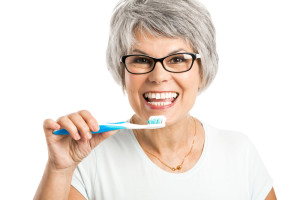Blog
An Introduction To Dental Bridges
 Find out more about dental bridges and learn how they can preserve your smile and protect your mouth.
Find out more about dental bridges and learn how they can preserve your smile and protect your mouth.
What is a dental bridge?
A dental bridge is a device that us used to correct the gap between missing teeth. It is a dental prosthetic that consists of two crowns—one crown is anchored to each side of the gap. In between these crowns, a false tooth is placed in the gap. If it is a large gap multiple false teeth may be used.
Why are dental bridges important?
There are a few benefits of using dental bridges. Some of these benefits include:
- A dental bridge will make it easier for you to eat and drink normally
- When there is a gap in your mouth, the rest of your teeth could become misaligned. A dental bridge can prevent further problems from developing.
- Sometimes missing teeth can make it difficult to speak or pronounce certain sounds. A dental bridge can make it easier to talk normally.
- It can be embarrassing to have a gap in your smile. Correcting the gap with a dental bridge can improve your appearance and make you feel more confident.
What are your options?
In most cases, Dr. Price uses a fixed bridge. This type of bridge is one of the most common types used. It is partially cemented into place unlike partial dentures that can be removed. This makes the bridge stronger and longer lasting.
Patients can choose between porcelain, alloyed metals, and gold when getting a dental bridge. Most patients make a decision based on their aesthetic preferences and their budget.
What is the procedure like?
Having dental bridges installed requires two visits. During the first visit an impression will be made of your teeth and this impression will be used to create the bridge. You’ll be given a temporary bridge while you wait for the permanent one to be finished. Once the permanent bridge is ready, you’ll come in for a second visit. The bridge will be installed during the second visit and adjusted for comfort. In some cases, patients come in for follow up visits to monitor the condition of the bridge.
If you’d like to learn more about dental bridges, schedule an appointment with Dr. Price.
Posted on September 30th, 2015
Are You Brushing Your Teeth Correctly?
 Hopefully you brush and floss your teeth every day, but it never hurts to check your habits and make sure you are doing things the best way.
Hopefully you brush and floss your teeth every day, but it never hurts to check your habits and make sure you are doing things the best way.
Here’s what you should know about brushing your teeth?
How often should you brush your teeth?
You should brush your teeth after each meal. To make it easier to keep your teeth clean during the day, keep a toothbrush and toothpaste in your purse, glove box, or desk drawer.
How long should it take to brush your teeth?
You should be brushing your teeth for at least two minutes. Use a timer to keep yourself on track and make sure you are brushing for as long as needed.
What kind of toothpaste should you use?
There are many types of toothpaste available. If you have a special issue, ask your dentist for advice. Normal toothpastes all have a few of the same types of ingredients—abrasives to dislodge particles, detergents to create bubbles, fluoride to keep your teeth strong, and mint oil for flavor.
What kind of toothbrush should you get?
In most cases, you should get a toothbrush with soft, rounded bristles. Choosing between a traditional toothbrush and a battery powered toothbrush is mostly up to personal preference. If you aren’t sure which type of toothbrush would be best, ask your dentist for advice.
What are common mistakes people make?
Although most people brush their teeth every day, there are a few common mistakes that you should avoid:
- Don’t brush your teeth too hard. This can actually damage the enamel and leave you more vulnerable to infection.
- Don’t brush without flossing. Flossing is just as important as brushing. It may help to floss before you brush your teeth.
- Don’t move the toothbrush back and forth. In most cases, it is better to move your toothbrush in small circles.
- Don’t skip dental cleanings because you have good oral hygiene at home. No matter how well you clean your teeth, there are some places that you will have trouble reaching. The dentist has tools to reach difficult areas and clean your mouth more thoroughly than you ever could at home.
To learn more about caring for your mouth, schedule a checkup with Dr. Price.
Posted on September 15th, 2015
Simple Ways To Get Whiter Teeth
Whiter teeth can improve your appearance and boost your confidence, but as people age, their teeth ac
Start With Good Oral Hygiene
Simple daily habits like brushing your teeth after meals and flossing every single day are the first step to getting whiter teeth. To make the most of these daily habits, use a whitening toothpaste and mouthwash.
Avoid Stains
Even if your teeth are already a little stained, avoiding more stains in the future will help you get and keep a whiter smile. The following tips can help you prevent stains:
- Stop smoking—it is bad for your health and bad for your teeth. If you need help, ask your doctor, your family, and your friends for support.
- Remember that coffee and red wine can stain your teeth. Don’t drink too much of either beverage. Sipping coffee through a straw can help you minimize the damage.
- Avoid brushing your teeth too hard. This can weaken your enamel, which is the first line of defense for your teeth. The enamel is also whiter than the tooth below it, so if your enamel is damaged, your teeth will look darker and stains will be more noticeable.
- Drink plenty of water, especially if you eat sugary foods or drink beverages that can stain your teeth. The water will help rinse out your mouth before stains settle in.
Ask About Veneers
Although there are some things you can do to keep your smile bright, you may not be able to get the smile you want all on your own. If you’re looking for a solution that gives you a healthy, brighter looking smile, veneers may be a good option. These coverings are molded and attached to your teeth so that they look completely natural. Veneers completely cover your teeth, so they’ll hide any stains you have. As an added bonus, veneers will protect your teeth in addition to making them look better.
If you’re interested in veneers, or other solutions that can protect your teeth and improve your appearance, schedule a checkup or dental cleaning with Dr. Stephen Price.
Posted on August 30th, 2015
Your Teeth And Their Functions—The Basics
 Did you know that adults usually have 32 teeth, including the wisdom teeth? But those 32 teeth aren’t all the same. You have four types of teeth, and each type of tooth has a specific role. Keep reading to find out more.
Did you know that adults usually have 32 teeth, including the wisdom teeth? But those 32 teeth aren’t all the same. You have four types of teeth, and each type of tooth has a specific role. Keep reading to find out more.
The Incisors
Your incisors are in the front of your mouth. You have four on the top row and four on the bottom row—8 in total. Although these teeth aren’t all the same size, they have the same job. They are used to bite into your food.
The Canines
The canines are positioned on the sides of your incisors. You have four canine teeth—two on top and two on bottom. These sharp, pointy teeth are good for gripping and ripping your food.
The Pre-Molars
Your pre-molars are larger and flatter than the incisors and canines. They are used for crushing and tearing food. Most adults have 8 pre-molar teeth.
The Molars
You have twelve molars, including your wisdom teeth, and these teeth are used for chewing and grinding your food so it can be swallowed and digested. These teeth are the largest in your mouth and they sit near the back.
The Parts Of The Tooth
While your teeth have different shapes and different jobs, they are made of the same parts:
There are two main parts to your teeth, the crown and the root.
The crown is the part of your teeth that you can see. It is exposed above the gums. The crown only makes up about 1/3 of your total tooth length.
The root is the longer part of the tooth that is positioned inside and below the gumline.
The other parts of your teeth include:
- The enamel is the hard white substance on the outside of your teeth. It is the first line of defense and protects the softer parts of your teeth when you chew.
- The dentin is the softer, yellowish, bone-like material underneath the enamel.
- Pulp is the soft stuff inside your teeth that provides nutrients that keep your teeth healthy and strong.
- Cementum and the periodontal ligament help connect your teeth to the rest of your jawbone.
To learn more about your teeth, schedule an appointment with Dr. Price.
Posted on August 15th, 2015
Healthy Diet And Healthy Teeth
The things you eat and drink have a substantial effect on the health of your teeth. Here’s what you should know before you plan your next meal:
What Should You Avoid?
Avoid the following foods and beverages to keep your teeth healthy:
- Sticky foods like dried fruits and caramel that leave residue on your teeth.
- Sugary sodas and fruit juices that feed bacteria.
- Acidic foods and beverages that break down enamel.
- Coffee, tea, and red wine that stain your teeth.
If you’ve had a lot of dental work done, you should avoid the foods and beverages listed above, but you should also avoid chewy foods like bagels and food that can easily get stuck in your teeth like popcorn.
What Should You Work Into Your Diet?
While some foods and beverages can be bad for your teeth, many others will keep your teeth healthy.
First things first, you should drink lots of water every day. Water rinses your mouth out, and dislodges things that get stuck. It also helps your mouth produce saliva—saliva is your body’s powerful bacteria killing tool. It works hard to keep your mouth clean and healthy. If you don’t drink enough water, your body can’t produce saliva that kills bacteria and keeps your mouth clean.
Other foods and beverages that will help your teeth stay healthy include:
- Dairy products like cheese, yogurt, and milk
- Leafy greens like spinach, kale, and lettuce
- Crunchy vegetables that are rich in nutrients such as carrots, broccoli, and celery
- Foods with vitamin C like strawberries
- Other fruits that have high water content like melons and apples
Eating foods with calcium, vitamin C, vitamin D, and protein will help your teeth stay strong, and protect your enamel.
If you have dentures, fillings, crowns, bridges, or other dental work, your dentist may have special instructions about what you should and should not eat. Ask your dentist for advice if you’re ever unsure about how eating a certain food will affect your teeth.
To learn more about protecting your smile and keeping your mouth healthy, schedule an appointment with Dr. Price.
Posted on July 30th, 2015
6 Reasons To Improve Your Smile
 Smiling has many impressive benefits, but if you’re self-conscious about your teeth, you might be missing out. Consider the following reasons to improve your smile.
Smiling has many impressive benefits, but if you’re self-conscious about your teeth, you might be missing out. Consider the following reasons to improve your smile.
1. Smiling Is Good For Your Health
Did you know that smiling releases endorphins that relieve stress, reduce anxiety, and improve your mood? Smiling can help boost your immune system, lower your heart rate, and reduce the sensation of pain. Smiling is a quick and simple way to make yourself feel a little better—try it today!
2. Smiling Can Help You At Work
People who smile are often perceived as more approachable, more trustworthy, and more confident. Smiling can also help you focus and stay productive. All these benefits can help you out in the workplace.
3. Smiling Can Improve Your Relationships
Smiling is contagious, so when you smile, you share the benefits of smiling with those around you. Smiling also encourages empathy and makes you appear more attractive. These benefits can pay off in your personal relationships whether they are platonic or romantic.
4. Improving Your Smile Can Boost Your Confidence
Having a clean, white, straight smile can boost your confidence and improve your self worth. Confidence will help you succeed in work and in life and it will help you stay happy and satisfied. Ask your dentist about veneers if you’re interested in getting a sparkling smile for years to come.
5. Improving Your Smile Can Improve Your Health
Many studies have linked oral health and overall health. For example, periodontal disease (or gingivitis) has been linked to diabetes and heart disease. Taking care of your smile is part of taking care of your health.
6. Improving Your Smile Can Make Your Life Easier
Ideally, you brush and floss your teeth every single day, but having crooked, misaligned teeth can make this process more difficult. Straightening your smile through Invisalign or can make it easier to thoroughly clean your teeth, which will keep your teeth and your gums healthy and strong.
To learn more about veneers, Invisalign, and other procedures that could improve your life and your smile, contact Dr. Stephen Price.
Posted on July 15th, 2015
Denture Care for Dummies
So you just decided that it’s time for you to get dentures. Before you make the final decision, there is a lot you should know, especially since dentures require more extra care than other options to replace missing teeth. So are you up to the denture challenge?
A Different Kind of Brushing
Just like you should brush your teeth every morning and night, you also need to brush your dentures. However, things will go down a little differently. First, you don’t want to use a normal toothbrush. Look for one with soft bristles that is specifically-designed for use on dentures. Next, do not use toothpaste. Brush with only water. These two conditions are to protect your dentures from abrasive materials and extra wear and tear.
Everything else is pretty self-explanatory. Brush all over to remove food and prevent stains. Rinse your dentures (meaning, remove them from your mouth) after every time you eat. You will also need to brush your gums and tongue, just like you did without your dentures. These parts of your mouth will still get dirty, and you need to prevent gum disease.
A Little TLC
Your dentures will be very fragile, so make sure to treat them with care. When brushing, do not brush too hard, and avoid damaging the plastic or attachments that will help them stay in your mouth. In addition, if you drop them they will break, so always hold them over a soft folded towel or a sink full of water.
Squeaky Clean and in Tip-Top Shape
If you can, buy special denture cleaner. At the very least, you need to use mild soap, such as hand soap or dishwashing liquid to clean your dentures. There are also some cleaning devices that use ultrasonic sound waves to clean extra debris off your dentures. Each night after you clean your dentures, place them in a denture solution to keep them from drying out and becoming misshapen.
If you have more questions about how to care for your dentures or what you can expect from these new “teeth,” talk to your dentist.
Posted on June 30th, 2015
3 Root Canal Myths – Busted!
 Patients are often afraid of root canals. But if you don’t want to lose your tooth, a root canal is a great option for you. Here are the most common root canal myths debunked to help you make a more informed decision.
Patients are often afraid of root canals. But if you don’t want to lose your tooth, a root canal is a great option for you. Here are the most common root canal myths debunked to help you make a more informed decision.
1. Root canals cause more pain than the original tooth pain.
While root canals aren’t entirely without discomfort, it’s a one-time procedure. You might have to go back for a checkup, but most of the time, the pain is over with very quickly. Compare that to a decayed tooth that can ache for days, weeks, or even months!
Need reassurance about the pain? Here are three great points to ease your mind:
– With current medicine and technology, root canals are relatively painless
– Sedation is available for root canal procedures
– Root canals are designed to relieve the pain of a decayed tooth
The myth of root canals being painful stems from an era of dentistry when anesthetics were not available and dental tools were unrefined. Root canal methods have improved greatly.
2. No pain? I don’t need a root canal!
Your dentist may recommend a root canal even if you haven’t been experiencing any significant pain. Just because you don’t feel anything doesn’t mean that your tooth is healthy! You might need a root canal if:
– Your tooth’s nerve and pulp have become infected due to decay
– Your tooth has been worked on extensively
– Your tooth has large or deep fillings
– Your tooth is chipped or cracked
Leaving a damaged tooth untreated can lead to even more severe damage, which may result in an extraction. Which leads to the next myth…
3. Extracting the tooth can spare you the hassle of having a root canal.
So your tooth’s gone bad. While you could save it with a root canal, you may as well just pull the tooth and get it over with. Right?
Not even close.
While current technology continues to move forward, there’s no artificial tooth that can perfectly replace a natural tooth. Extracting your tooth means:
– You’ll be paying more money
– You’ll have a longer recovery time
– You’ll have to be more cautious when eating
– You’ll have to adjust your neighboring teeth
Dental professionals , as a general rule, always try to save your natural tooth. It’s less expensive for you, both in terms of time and money. Plus, you get to keep what you were born with – natural teeth are the very best at what they do.
Hopefully you have a better understanding of why root canals aren’t so bad. If you need a root canal, call us to schedule an appointment!
Posted on June 15th, 2015
Hold Your Sweet Tooth: What Causes Tooth Sensitivity to Sweets?
 Often your teeth can become overly sensitive to various conditions, including temperatures. But did you know that this can also happen with sweets? If you went to chomp down on your favorite candy bar or cotton candy and realized that your teeth were in pain, you probably worried for a bit. Do you need to stop eating sugar? Is there are serious problem with your teeth?
Often your teeth can become overly sensitive to various conditions, including temperatures. But did you know that this can also happen with sweets? If you went to chomp down on your favorite candy bar or cotton candy and realized that your teeth were in pain, you probably worried for a bit. Do you need to stop eating sugar? Is there are serious problem with your teeth?
The short (and good) answer is no. No matter how intense or serious the pain is, if it is short and stops after you brush your teeth, don’t worry about it too much. However, you should definitely mention the pain to your dentist, and he or she will be able to tell you the best way to treat it and whether or not it is a more serious problem that requires something more than cleaning.
Dentin Hypersensitivity
This sugary sensitivity is brought on by a condition called “dentin hypersensitivity.” This is where the dentin or pulp of the tooth is exposed due to worn down enamel and is usually caused by improper dental care. It is often brought on by cavities, gum disease, or receding gums. Essentially, the damage from the sugar is exposing the more sensitive areas of your teeth to the air, elements, and bacteria.
It is characterized by intense and severe pain in your tooth. While this pain is very quickly onset, it does not last very long. In fact, if the pain is prolonged, it is a sign of deep damage. If the pain is short, the tooth can be repaired by a simple visit to the dentist. If the dentin is damaged further, your dentist will give you a course of action.
What Causes It?
Although we’ve already mentioned a few potential causes, dentin hypersensitivity can also be caused by:
- Brushing your teeth too hard or with a toothbrush with too hard of bristles
- Not enough vitamin C in your diet
- Tooth trauma like a chipped or cracked tooth
If you’re experiencing this sensitivity, talk to your dentist, and he or she will help you find relief so you can return to your desserts!
Posted on May 30th, 2015
Creating Your Invisible Smile
 We all know about how Invisalign is a popular alternative to braces. We know that they’re clear, retainer-like aligners that fit to your mouth in order to slowly move your teeth into the proper position. Whether you’re wearing them for bite issues or for aesthetic ones, Invisalign fits comfortably and seamlessly. But have you ever wondered how they are made so perfectly?
We all know about how Invisalign is a popular alternative to braces. We know that they’re clear, retainer-like aligners that fit to your mouth in order to slowly move your teeth into the proper position. Whether you’re wearing them for bite issues or for aesthetic ones, Invisalign fits comfortably and seamlessly. But have you ever wondered how they are made so perfectly?
The Bare Beginnings
Obviously, the Invisalign process starts with your teeth. After you’ve decided to use Invisalign, your dentist will take an impression of your mouth. While this might be uncomfortable, it is the worst part of the whole process. And it is most important! Every other aspect of making the aligners will come back to the shape of your teeth that is recorded by the molding process.
Turning Your Teeth Digital
After the dentist has the physical impression of your teeth, things get pixelated. That is, the dentist then uses a computer, together with the impression, to make a digital 3D model of your mouth. This step is the bridge between your current mouth (the impression) and the actual aligners that will go in your mouth. During this stage, you and your dentist consult together to form a plan of action.
Serious Stereolithography
The 3D digital model is then transferred to another 3D physical model via stereolithography. This process is technically complicated, but essentially, it uses laser beams to quickly solidify layers of previously-liquid resin. This technology allows these models to be made in just a day!
The Final Fittings
After the dental model is physically made, an automated forming system creates each liner that you will wear. These are then trimmed for comfort and delivered to you. When your dentist calls you in, he or she will carefully check that the aligners fit your mouth perfectly. While they might be a bit painful at first, this is normal with any sort of realignment system.
Now that you know how Invisalign “braces” are made, you can more fully appreciate how easy it really is to help straighten your teeth. It’s so simple—for both you and your dentist.
Posted on May 15th, 2015




